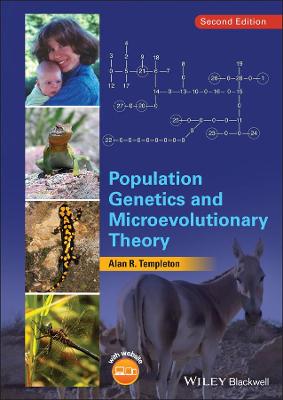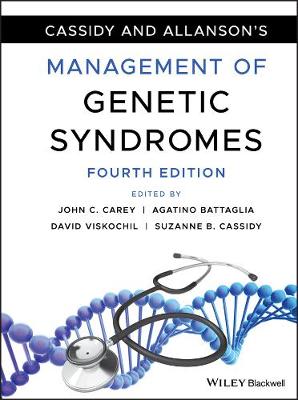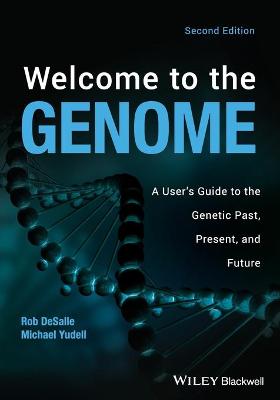Population Genetics and Microevolutionary Theory
 -15%
portes grátis
-15%
portes grátis
Population Genetics and Microevolutionary Theory
Templeton, Alan R.
John Wiley and Sons Ltd
06/2021
768
Dura
Inglês
9781118504239
15 a 20 dias
1730
Descrição não disponível.
Preface to the 2nd Edition ix
Chapter 1. The Scope and Basic Premises of Population Genetics 1-1
Basic Premises of Population Genetics 1-1
Population Genomics1-12
Section 1: Population Structure and History
Chapter 2. Modeling Evolution and the Hardy-Weinberg Law 2-1
How to Model Microevolution 2-1
The Hardy-Weinberg Model 2-4
Hardy-Weinberg for Two Loci2-19
Chapter 3. Systems of Mating 3-1
Inbreeding 3-1
Assortative Mating3-25
Disassortative Mating3-45
Chapter 4. Genetic Drift 4-1
Basic Evolutionary Properties of Genetic Drift 4-2
Founder and Bottleneck Effects 4-7
Genetic Drift and Disequilibrium4-11
Genetic Drfit, Disequilibrium, and System of Mating4-13
Effective Population Size4-18
Chapter 5. Genetic Drift in Large Populations and Coalescence 5-1
Newly Arisen Mutations 5-1
Neutral Alleles 5-3
The Coalescent5-22
Chapter 6. Gene Flow and Population Subdivision 6-1
Gene Flow Between Two Local Populations 6-1
The Balance of Gene Flow and Drift 6-6
An Example of the Balance of Drift and Gene Flow6-27
Factors Influencing The Amount and Patter of Gene Flow6-42
Total Effective Population Size in Subdivided Populations6-62
Multiple Modes of Inheritance and Population Structure6-71
Admixture6-76
Identifying Subpopulations and Population Structure6-81
A Final Warning6-96
Chapter 7. Population History 7-1
Inferring Historical Effective Population Sizes 7-6
Inferring Historical Gene Flow Patterns and Admixture 7-11
Using Haplotype Trees to Study Population History 7-19
Model Based Approaches to Phylogeographic Analysis 7-56
Direct Studies Over Space and Past Times 7-70
Historical Population Genetics and Macroevolution 7-75
Section 2: Genotype and Phenotype
Chapter 8. Basic Quantitative Genetic Definitions and Theory 8-1
"Simple" Mendelian Phenotypes 8-2
Nature Versus Nurture? 8-7
The Fisherian Model of Quantitative Genetics8-13
Chapter 9. Quantitative Genetics: Unmeasured Genotypes 9-1
Correlation Between Relatives 9-2
The Distinction Between Heritability and Inheritance9-17
Response to Selection9-19
The Problem of Between-Population Differences in Mean
Phenotype 9-21
Controlled Crosses for the Analysis of Between Population
Differences 9-30
The Balance Between Mutation, Drift, and Gene Flow Upon
Phenotypic Variance 9-36
Chapter 10. Quantitative Genetics: Measured Genotypes 10-1
Marker Association Studies 10-5
Candidate Loci10-35
Candidate Loci and Genetic Architecture10-51
Section 3: Natural Selection and Adaptation
Chapter 11. Natural Selection 11-1
The Fundamental Equation of Natural Selection: Measured
Genotypes 11-4
Sickle-Cell Anemia as an Example of Natural Selection 11-10
Adaptation as a Polygenic Process 11-24
The Fundamental Theorem of Natural Selection: Unmeasured
Genotypes 11-29
Some Implications of the Fundamental Equations of Natural
Selection 11-33
The Course of Adaptation and Natural Selection 11-47
Chapter 12. Interactions of Natural Selection with Other Evolutionary Forces
and the Detection of Natural Selection 12-1
The Interaction of Natural Selection with Mutation 12-3
The Interaction of Natural Selection with Mutation and System of
Mating 12-8
The Interaction of Natural Selection with Gene Flow 12-12
The Interaction of Natural Selection with Genetic Drift 12-21
The Interactions of Natural Selection, Genetic Drift, and
Gene Flow 12-28
The Interactions of Natural Selection, Genetic Drift, and Mutation 12-45
The Interactions of Natural Selection, Genetic Drift, Mutation, and
Recombination 12-65
Candidate Loci 12-71
Quantitative Genetic Approaches to Detecting Selection 12-75
The Neutralist/Selectionist Debate 12-80
Chapter 13. Units and Targets of Selection 13-1
The Unit of Selection 13-4
Targets of Selection Below the Level of the Individual 13-18
Targets of Selection Above the Level of the Individual 13-51
Chapter 14. Selection in Heterogeneous Environments 14-1
Coarse-Grained Spatial Heterogeneity 14-4
Coarse-Grained Temporal Heterogeneity 14-34
Fine-Grained Heterogeneity 14-56
Coevolution 14-74
Chapter 15. Selection in Age-Structured Populations 15-1
Life History and Fitness 15-3
The Evolution of Senescence 15-13
Abnormal Abdomen: An Example of Selection in an
Age-Structured Population 15-24
Overview 15-63
Appendices
Appendix 1. Genetic Survey Techniques A1-1
Appendix 2. Probability and Statistics A2-1
References R-1
Index
Chapter 1. The Scope and Basic Premises of Population Genetics 1-1
Basic Premises of Population Genetics 1-1
Population Genomics1-12
Section 1: Population Structure and History
Chapter 2. Modeling Evolution and the Hardy-Weinberg Law 2-1
How to Model Microevolution 2-1
The Hardy-Weinberg Model 2-4
Hardy-Weinberg for Two Loci2-19
Chapter 3. Systems of Mating 3-1
Inbreeding 3-1
Assortative Mating3-25
Disassortative Mating3-45
Chapter 4. Genetic Drift 4-1
Basic Evolutionary Properties of Genetic Drift 4-2
Founder and Bottleneck Effects 4-7
Genetic Drift and Disequilibrium4-11
Genetic Drfit, Disequilibrium, and System of Mating4-13
Effective Population Size4-18
Chapter 5. Genetic Drift in Large Populations and Coalescence 5-1
Newly Arisen Mutations 5-1
Neutral Alleles 5-3
The Coalescent5-22
Chapter 6. Gene Flow and Population Subdivision 6-1
Gene Flow Between Two Local Populations 6-1
The Balance of Gene Flow and Drift 6-6
An Example of the Balance of Drift and Gene Flow6-27
Factors Influencing The Amount and Patter of Gene Flow6-42
Total Effective Population Size in Subdivided Populations6-62
Multiple Modes of Inheritance and Population Structure6-71
Admixture6-76
Identifying Subpopulations and Population Structure6-81
A Final Warning6-96
Chapter 7. Population History 7-1
Inferring Historical Effective Population Sizes 7-6
Inferring Historical Gene Flow Patterns and Admixture 7-11
Using Haplotype Trees to Study Population History 7-19
Model Based Approaches to Phylogeographic Analysis 7-56
Direct Studies Over Space and Past Times 7-70
Historical Population Genetics and Macroevolution 7-75
Section 2: Genotype and Phenotype
Chapter 8. Basic Quantitative Genetic Definitions and Theory 8-1
"Simple" Mendelian Phenotypes 8-2
Nature Versus Nurture? 8-7
The Fisherian Model of Quantitative Genetics8-13
Chapter 9. Quantitative Genetics: Unmeasured Genotypes 9-1
Correlation Between Relatives 9-2
The Distinction Between Heritability and Inheritance9-17
Response to Selection9-19
The Problem of Between-Population Differences in Mean
Phenotype 9-21
Controlled Crosses for the Analysis of Between Population
Differences 9-30
The Balance Between Mutation, Drift, and Gene Flow Upon
Phenotypic Variance 9-36
Chapter 10. Quantitative Genetics: Measured Genotypes 10-1
Marker Association Studies 10-5
Candidate Loci10-35
Candidate Loci and Genetic Architecture10-51
Section 3: Natural Selection and Adaptation
Chapter 11. Natural Selection 11-1
The Fundamental Equation of Natural Selection: Measured
Genotypes 11-4
Sickle-Cell Anemia as an Example of Natural Selection 11-10
Adaptation as a Polygenic Process 11-24
The Fundamental Theorem of Natural Selection: Unmeasured
Genotypes 11-29
Some Implications of the Fundamental Equations of Natural
Selection 11-33
The Course of Adaptation and Natural Selection 11-47
Chapter 12. Interactions of Natural Selection with Other Evolutionary Forces
and the Detection of Natural Selection 12-1
The Interaction of Natural Selection with Mutation 12-3
The Interaction of Natural Selection with Mutation and System of
Mating 12-8
The Interaction of Natural Selection with Gene Flow 12-12
The Interaction of Natural Selection with Genetic Drift 12-21
The Interactions of Natural Selection, Genetic Drift, and
Gene Flow 12-28
The Interactions of Natural Selection, Genetic Drift, and Mutation 12-45
The Interactions of Natural Selection, Genetic Drift, Mutation, and
Recombination 12-65
Candidate Loci 12-71
Quantitative Genetic Approaches to Detecting Selection 12-75
The Neutralist/Selectionist Debate 12-80
Chapter 13. Units and Targets of Selection 13-1
The Unit of Selection 13-4
Targets of Selection Below the Level of the Individual 13-18
Targets of Selection Above the Level of the Individual 13-51
Chapter 14. Selection in Heterogeneous Environments 14-1
Coarse-Grained Spatial Heterogeneity 14-4
Coarse-Grained Temporal Heterogeneity 14-34
Fine-Grained Heterogeneity 14-56
Coevolution 14-74
Chapter 15. Selection in Age-Structured Populations 15-1
Life History and Fitness 15-3
The Evolution of Senescence 15-13
Abnormal Abdomen: An Example of Selection in an
Age-Structured Population 15-24
Overview 15-63
Appendices
Appendix 1. Genetic Survey Techniques A1-1
Appendix 2. Probability and Statistics A2-1
References R-1
Index
Este título pertence ao(s) assunto(s) indicados(s). Para ver outros títulos clique no assunto desejado.
Preface to the 2nd Edition ix
Chapter 1. The Scope and Basic Premises of Population Genetics 1-1
Basic Premises of Population Genetics 1-1
Population Genomics1-12
Section 1: Population Structure and History
Chapter 2. Modeling Evolution and the Hardy-Weinberg Law 2-1
How to Model Microevolution 2-1
The Hardy-Weinberg Model 2-4
Hardy-Weinberg for Two Loci2-19
Chapter 3. Systems of Mating 3-1
Inbreeding 3-1
Assortative Mating3-25
Disassortative Mating3-45
Chapter 4. Genetic Drift 4-1
Basic Evolutionary Properties of Genetic Drift 4-2
Founder and Bottleneck Effects 4-7
Genetic Drift and Disequilibrium4-11
Genetic Drfit, Disequilibrium, and System of Mating4-13
Effective Population Size4-18
Chapter 5. Genetic Drift in Large Populations and Coalescence 5-1
Newly Arisen Mutations 5-1
Neutral Alleles 5-3
The Coalescent5-22
Chapter 6. Gene Flow and Population Subdivision 6-1
Gene Flow Between Two Local Populations 6-1
The Balance of Gene Flow and Drift 6-6
An Example of the Balance of Drift and Gene Flow6-27
Factors Influencing The Amount and Patter of Gene Flow6-42
Total Effective Population Size in Subdivided Populations6-62
Multiple Modes of Inheritance and Population Structure6-71
Admixture6-76
Identifying Subpopulations and Population Structure6-81
A Final Warning6-96
Chapter 7. Population History 7-1
Inferring Historical Effective Population Sizes 7-6
Inferring Historical Gene Flow Patterns and Admixture 7-11
Using Haplotype Trees to Study Population History 7-19
Model Based Approaches to Phylogeographic Analysis 7-56
Direct Studies Over Space and Past Times 7-70
Historical Population Genetics and Macroevolution 7-75
Section 2: Genotype and Phenotype
Chapter 8. Basic Quantitative Genetic Definitions and Theory 8-1
"Simple" Mendelian Phenotypes 8-2
Nature Versus Nurture? 8-7
The Fisherian Model of Quantitative Genetics8-13
Chapter 9. Quantitative Genetics: Unmeasured Genotypes 9-1
Correlation Between Relatives 9-2
The Distinction Between Heritability and Inheritance9-17
Response to Selection9-19
The Problem of Between-Population Differences in Mean
Phenotype 9-21
Controlled Crosses for the Analysis of Between Population
Differences 9-30
The Balance Between Mutation, Drift, and Gene Flow Upon
Phenotypic Variance 9-36
Chapter 10. Quantitative Genetics: Measured Genotypes 10-1
Marker Association Studies 10-5
Candidate Loci10-35
Candidate Loci and Genetic Architecture10-51
Section 3: Natural Selection and Adaptation
Chapter 11. Natural Selection 11-1
The Fundamental Equation of Natural Selection: Measured
Genotypes 11-4
Sickle-Cell Anemia as an Example of Natural Selection 11-10
Adaptation as a Polygenic Process 11-24
The Fundamental Theorem of Natural Selection: Unmeasured
Genotypes 11-29
Some Implications of the Fundamental Equations of Natural
Selection 11-33
The Course of Adaptation and Natural Selection 11-47
Chapter 12. Interactions of Natural Selection with Other Evolutionary Forces
and the Detection of Natural Selection 12-1
The Interaction of Natural Selection with Mutation 12-3
The Interaction of Natural Selection with Mutation and System of
Mating 12-8
The Interaction of Natural Selection with Gene Flow 12-12
The Interaction of Natural Selection with Genetic Drift 12-21
The Interactions of Natural Selection, Genetic Drift, and
Gene Flow 12-28
The Interactions of Natural Selection, Genetic Drift, and Mutation 12-45
The Interactions of Natural Selection, Genetic Drift, Mutation, and
Recombination 12-65
Candidate Loci 12-71
Quantitative Genetic Approaches to Detecting Selection 12-75
The Neutralist/Selectionist Debate 12-80
Chapter 13. Units and Targets of Selection 13-1
The Unit of Selection 13-4
Targets of Selection Below the Level of the Individual 13-18
Targets of Selection Above the Level of the Individual 13-51
Chapter 14. Selection in Heterogeneous Environments 14-1
Coarse-Grained Spatial Heterogeneity 14-4
Coarse-Grained Temporal Heterogeneity 14-34
Fine-Grained Heterogeneity 14-56
Coevolution 14-74
Chapter 15. Selection in Age-Structured Populations 15-1
Life History and Fitness 15-3
The Evolution of Senescence 15-13
Abnormal Abdomen: An Example of Selection in an
Age-Structured Population 15-24
Overview 15-63
Appendices
Appendix 1. Genetic Survey Techniques A1-1
Appendix 2. Probability and Statistics A2-1
References R-1
Index
Chapter 1. The Scope and Basic Premises of Population Genetics 1-1
Basic Premises of Population Genetics 1-1
Population Genomics1-12
Section 1: Population Structure and History
Chapter 2. Modeling Evolution and the Hardy-Weinberg Law 2-1
How to Model Microevolution 2-1
The Hardy-Weinberg Model 2-4
Hardy-Weinberg for Two Loci2-19
Chapter 3. Systems of Mating 3-1
Inbreeding 3-1
Assortative Mating3-25
Disassortative Mating3-45
Chapter 4. Genetic Drift 4-1
Basic Evolutionary Properties of Genetic Drift 4-2
Founder and Bottleneck Effects 4-7
Genetic Drift and Disequilibrium4-11
Genetic Drfit, Disequilibrium, and System of Mating4-13
Effective Population Size4-18
Chapter 5. Genetic Drift in Large Populations and Coalescence 5-1
Newly Arisen Mutations 5-1
Neutral Alleles 5-3
The Coalescent5-22
Chapter 6. Gene Flow and Population Subdivision 6-1
Gene Flow Between Two Local Populations 6-1
The Balance of Gene Flow and Drift 6-6
An Example of the Balance of Drift and Gene Flow6-27
Factors Influencing The Amount and Patter of Gene Flow6-42
Total Effective Population Size in Subdivided Populations6-62
Multiple Modes of Inheritance and Population Structure6-71
Admixture6-76
Identifying Subpopulations and Population Structure6-81
A Final Warning6-96
Chapter 7. Population History 7-1
Inferring Historical Effective Population Sizes 7-6
Inferring Historical Gene Flow Patterns and Admixture 7-11
Using Haplotype Trees to Study Population History 7-19
Model Based Approaches to Phylogeographic Analysis 7-56
Direct Studies Over Space and Past Times 7-70
Historical Population Genetics and Macroevolution 7-75
Section 2: Genotype and Phenotype
Chapter 8. Basic Quantitative Genetic Definitions and Theory 8-1
"Simple" Mendelian Phenotypes 8-2
Nature Versus Nurture? 8-7
The Fisherian Model of Quantitative Genetics8-13
Chapter 9. Quantitative Genetics: Unmeasured Genotypes 9-1
Correlation Between Relatives 9-2
The Distinction Between Heritability and Inheritance9-17
Response to Selection9-19
The Problem of Between-Population Differences in Mean
Phenotype 9-21
Controlled Crosses for the Analysis of Between Population
Differences 9-30
The Balance Between Mutation, Drift, and Gene Flow Upon
Phenotypic Variance 9-36
Chapter 10. Quantitative Genetics: Measured Genotypes 10-1
Marker Association Studies 10-5
Candidate Loci10-35
Candidate Loci and Genetic Architecture10-51
Section 3: Natural Selection and Adaptation
Chapter 11. Natural Selection 11-1
The Fundamental Equation of Natural Selection: Measured
Genotypes 11-4
Sickle-Cell Anemia as an Example of Natural Selection 11-10
Adaptation as a Polygenic Process 11-24
The Fundamental Theorem of Natural Selection: Unmeasured
Genotypes 11-29
Some Implications of the Fundamental Equations of Natural
Selection 11-33
The Course of Adaptation and Natural Selection 11-47
Chapter 12. Interactions of Natural Selection with Other Evolutionary Forces
and the Detection of Natural Selection 12-1
The Interaction of Natural Selection with Mutation 12-3
The Interaction of Natural Selection with Mutation and System of
Mating 12-8
The Interaction of Natural Selection with Gene Flow 12-12
The Interaction of Natural Selection with Genetic Drift 12-21
The Interactions of Natural Selection, Genetic Drift, and
Gene Flow 12-28
The Interactions of Natural Selection, Genetic Drift, and Mutation 12-45
The Interactions of Natural Selection, Genetic Drift, Mutation, and
Recombination 12-65
Candidate Loci 12-71
Quantitative Genetic Approaches to Detecting Selection 12-75
The Neutralist/Selectionist Debate 12-80
Chapter 13. Units and Targets of Selection 13-1
The Unit of Selection 13-4
Targets of Selection Below the Level of the Individual 13-18
Targets of Selection Above the Level of the Individual 13-51
Chapter 14. Selection in Heterogeneous Environments 14-1
Coarse-Grained Spatial Heterogeneity 14-4
Coarse-Grained Temporal Heterogeneity 14-34
Fine-Grained Heterogeneity 14-56
Coevolution 14-74
Chapter 15. Selection in Age-Structured Populations 15-1
Life History and Fitness 15-3
The Evolution of Senescence 15-13
Abnormal Abdomen: An Example of Selection in an
Age-Structured Population 15-24
Overview 15-63
Appendices
Appendix 1. Genetic Survey Techniques A1-1
Appendix 2. Probability and Statistics A2-1
References R-1
Index
Este título pertence ao(s) assunto(s) indicados(s). Para ver outros títulos clique no assunto desejado.




